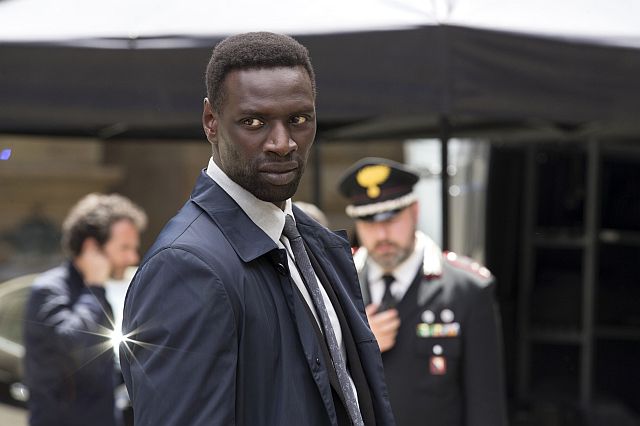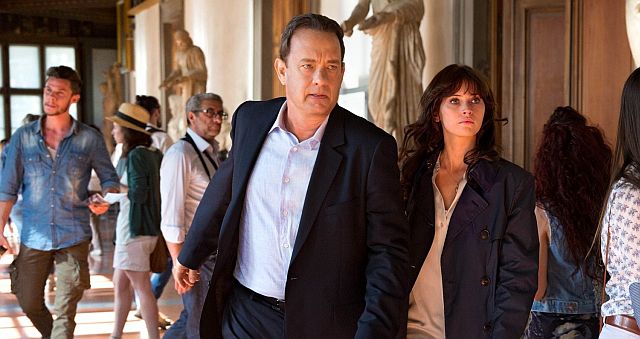
Omar Sy in Columbia Pictures’ “Inferno,” starring Tom Hanks and Felicity Jones.
Academy Award winner Tom Hanks returns as Robert Langdon, the Harvard University professor-turned-super sleuth in his greatest adventure to save the future of humanity in the mystery thriller, “Inferno.”
Ripped from the pages of Dan Brown’s best-selling novel, the film has Hanks once again teaming up with director Ron Howard in this third of Brown’s adapted works for the screen. Hanks’ Langdon debuted in the controversial “The Da Vinci Code” in 2006 and “Angels and Demons” in 2009 where the novelist clearly showed that he has no love lost for the Roman Catholic Church.
In “The Da Vinci Code,” Brown’s Langdon chased down the Holy Grail, the reported cup used by Jesus the Christ during the Last Supper, only to find evidence that Jesus himself was father to a child whose descendants live on today.
In “Angels and Demons,” Brown once again did fierce verbal battle with the Roman Catholic Church and its selection process of a new Pope amid an overthrow of the Church (and the Papacy) from within.
This time, albeit with a seven-year cinema absence, Langdon once again is in hot pursuit of ancient (and well-guarded) relics from the Catholic Church as this time he is after nothing less than the secrets of Dante’s Inferno — hence the book and this film’s title.
Controversy follows Brown wherever he goes, and his writings are nothing less than sacrilegious to any of the Catholic faithful, stirring up hearts and minds with new thinking long repressed during the centuries. In “Inferno,” he dumps a truckload of gasoline onto this fiery dispute as his hero Langdon is the target of a major manhunt as he races through Florence, Italy, with no memory of the past few days and on the run with a mad (as in crazy) female assassin (Ana Ularu) hot on his heels.
Filmed on location in Venice, Langdon seeks the help of a beautiful doctor, Sienna Brooks (Felicity Jones) who may or may not be an ally. Clearly the US Consulate will be of no help to Langdon as he gives them a false address during a frantic call for help to see if they also are part of this widespread conspiracy. And wouldn’t you just know it, seconds later, out pops this same gun-wielding killer ever searching for him.
Watching “Inferno” is akin to looking for that earring lost in a couch — or your car keys where you knew exactly where you left them but are no longer there.

Tom Hanks and Felicity Jones star in Columbia PIctures’ “Inferno.”
As he searches through one clue and another, Langdon becomes himself caught up in a wild dash to not only find the answers to Dante’s Inferno but eventually (don’t laugh) to a super virus that the film’s ultimate villain plans to unleash upon the world’s population which will make 1/3 of all women forever sterile.
It is Langdon’s incredible use of symbology that helps him crack the obscure and hidden writings of Dante that, according to Brown, have been long buried by generations of Catholic leaders that steers Langdon from one church to another across Florence.
Both Langdon and Brooks are always just seconds away from being caught either by the police or by “The Consortium,” a secret society created from fringe members of the World Health Organization with its leader Bertrand Zobrist (Ben Foster) intent on solving the world’s overpopulation problems.
It seems that no one is Langdon’s true ally in “Inferno.” There are few, if any, he can trust and throughout the film, only fragments of his memory returns — of course at the right moments — that help Hanks’ Langdon piece together the evil plans of Zobrist.
It’s all for fun of course and no one should take any of this seriously.
But the author Dan Brown is very grim indeed.
He not only invites controversy with his novels’ essays (and later in films) about the inner workings of the Roman Catholic Church, he seems to beg for a fight. Rather than put his hero Langdon on a pathway to “truth and virtue,” Brown is in constant combat with the Church’s “true believers” who, in Brown’s view, have everything to lose should Langdon find out the truth — wherever it may take him — with the movie-going audience being dragged along.
Rather than concentrate on the supposed prodigy of Jesus, “Inferno” asks even more questions to the audience. Can any works from the medieval time period be trusted? Did Dante actually write his famed “Inferno” or was it a product of the Church itself to cast terror into the hearts of its worshippers to control their daily affairs? Not going to heaven because you don’t conform is a powerful control tactic — going the other direction into Hades and each of its horrific multiple descending levels, according to Dante’s “Inferno,” strikes terror into even the most strident disciple.
Brown does everything but tell us who during the medieval period came up with the notion that angels are heavenly beings with feathered wings. Nothing in “Inferno” is sacred, and Hanks does a wonderful job keeping a straight face through all of it.
If you are seeking answer to religious questions that may be haunting your soul, you clearly will not find it in “Inferno,” which starts out as a great chase through a beautiful Italian city but ends up being much more than a travel guide.
Questions, comments or travel suggestions, write me at [email protected].

